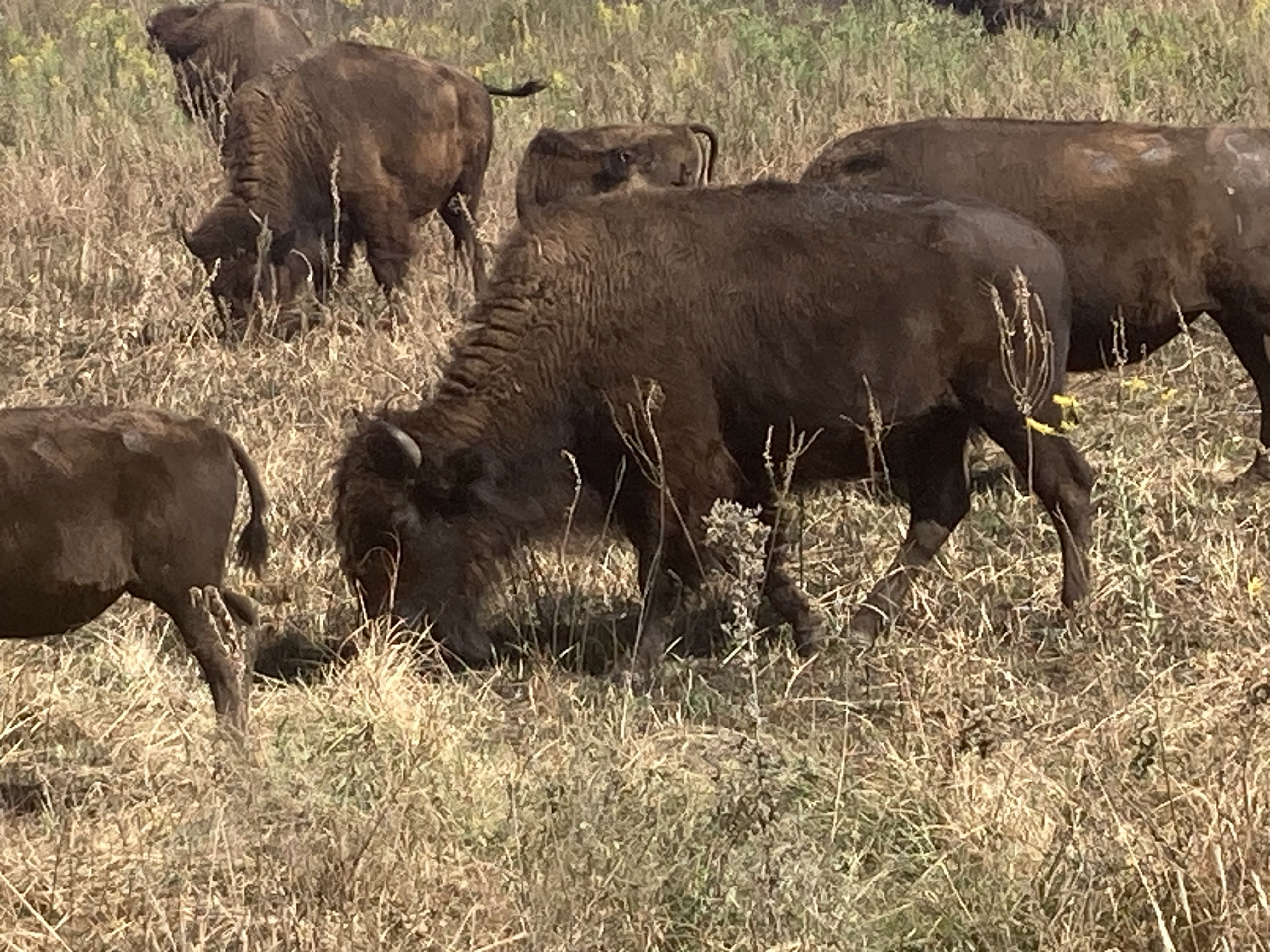Buffalo aka Bison
Contact
University of Arkansas System Division of Agriculture
Cooperative Extension Service
2301 S. University Ave.
Little Rock, AR 72204

Buffalo aka Bison
I have always had a soft spot in my heart for buffalo. Perhaps because my third-grade teacher lined us up for a rousing chorus of “Home on the Range,” in which the traditional cowboy song begins, “Oh give me a home where the buffalo roam.” That and the fact the hilltop where I lived most of my childhood was pock-marked with buffalo wallows. Their presence seemed real even though they were long gone. So, every chance I get, I stop by the Nature Conservancy’s Tallgrass Prairie Preserve near Pawhuska, Oklahoma to visit their large herd that roam freely on 45,000 acres of prairie.
There used to be a lot of buffalo. Or should we call them bison? Samuel de Champlain, the French explorer who founded Quebec, described the pelts and sketches he was shown in 1616 as coming from “boeuf.” Later French trappers called them buffalo. The name bison was not used until the 1750s, when the binomial system of naming was adopted to scientifically categorize flora and fauna. Interestingly, in 2021 the taxonomists who classify mammals did away with the genus name “Bison” and moved the European and North American bison species to the genus “Bos,” where all the cows and cow-like animals are classified. So it goes with names.
The number of buffalo found in North America during the period of western expansion will never be known but I’ve read estimates from 20 million to 100 million animals, with 60 million seeming to be a consensus view. George Catlin, the American painter who worked during the 1830s in the American West when buffalo still roamed the prairies in enormous herds, depicted some of these in his paintings. In 1871 Richard Dodge, an army Lieutenant Colonel, described a herd so large it took his troops five days to pass by.
In his book “1491, New Revelations of the Americas before Columbus,” Charles Mann quotes sources who claim that the massive number of bison seen in the 19th century were an artificial blip in population numbers caused by the die-off of the indigenous tribes who hunted them and used every part of their carcass for food and shelter. When Hernando De Soto explored Arkansas in 1541, he saw lots of Native Americans (including the site near Parkin), but his chroniclers never mentioned buffalo. When LaSalle canoed down the Mississippi River in 1682, he reported a virtual wilderness teeming with game but with almost no people. During the early part of the 19th century, smallpox devastated many Great Plains tribes, killing from 50 to 90 percent of the population. Remove the principal predator and any population will explode.
But the unrelenting push for western expansion and settlement in the mid-19th century led to a rapid and dramatic kill-off of these 2,000-pound animals that is almost unbelievable. It mostly began after the Civil War, increased rapidly as railroads pushed into the Great Plains and was almost over by the early 1880s, when several Indian tribes had their last, mostly unsuccessful hunts.
The first calamity to the herd was the intrusion of the first continental railroad through the prairies which effectively separated the buffalo into a northern and southern herd. Railroad campaigns advertised excursions to “hunt” buffalo from the comfort of the train. Slain animals were simply left to rot in the summer sun.
The arrival of the railroads created a way to transport buffalo hides and commercial hunters moved across the prairies like packs of wolves. Buffalo, while quick of foot and with a reputation for unpredictable charges, are not especially bright. When hunters opened up with their 50 caliber Sharps rifles from about 100 yards, the buffalo milled about trying to figure out what was going on. Eventually, the herd would spook and run off, leaving behind a hundred or more mortally wounded or dead animals. A couple of shooters could keep a dozen or more skinners busy while teamsters loaded the fresh pelts for transport to the nearest depot. The tongue was also taken, being considered a delicacy.
Cormac McCarthy’s book “Blood Meridian” ends with the final stage of this gruesome harvest as bone pickers fan out across the prairies picking up the bleached bones of these noble animals. The bones were shipped east on the railroads to be made into fertilizer.
The United States government was ambivalent – or perhaps supportive is a better word – during this period of wanton destruction. When the Texas legislature considered passing laws to stop the killing, General Philip Sheridan said, “These men have done more in the last two years, and will do more in the next year, to settle the vexed Indian question, than the entire regular army has done in the last 40 years. They are destroying the Indians' commissary. Send them powder and lead, if you will; but for a lasting peace, let them kill, skin, and sell until the buffaloes are exterminated. Then your prairies can be covered with speckled cattle."
Then, about 1890, a few people realized what was happening and sheltered a few buffalo calves. The Yellowstone herd was the only free-ranging population that existed but it only numbered 23 animals. All told, the population of millions had been reduced to 1,100 animals. Today it is estimated there are about 350,000 buffalo in North America. A number of these animals carry a small load of bovine DNA, but they persist to remind us of what once was.
